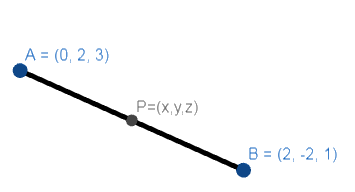
Find the locus of the point which is equidistant from the points A(0, 2, 3) and B(2, -2, 1).
Answer
605.1k+ views
Hint: Take the point P as (x, y, z) use the distance formula which is,
$\sqrt{{{\left( {{x}_{2}}-{{x}_{1}} \right)}^{2}}+{{\left( {{y}_{2}}-{{y}_{1}} \right)}^{2}}+{{\left( {{z}_{2}}-{{z}_{1}} \right)}^{2}}}$. Then equate PA and PB as they are equidistant and find the result.
Complete step-by-step answer:
Let P assume a point (x, y, z) such that PA distance is always equal to PB distance, as shown in figure below:

Then we can represent it as
PA = PB
As the values are the same then if we square their values it will also remain the same.
So we can say,
$P{{A}^{2}}=P{{B}^{2}}$
At first for finding PA we have to use distance formula which is
$\sqrt{{{\left( {{x}_{2}}-{{x}_{1}} \right)}^{2}}+{{\left( {{y}_{2}}-{{y}_{1}} \right)}^{2}}+{{\left( {{z}_{2}}-{{z}_{1}} \right)}^{2}}}$
Where the points are $\left( {{x}_{1}},{{y}_{1}},{{z}_{1}} \right)$ and $\left( {{x}_{2}},{{y}_{2}},{{z}_{2}} \right)$ whose distance is to find out.
So if point are P(x, y, z) and A(0,2,3)
Then,
$PA=\sqrt{{{\left( x-0 \right)}^{2}}+{{\left( y-2 \right)}^{2}}+{{\left( z-3 \right)}^{2}}}$
Now if points are P(x, y, z) and B (2,-2,1).
$PB=\sqrt{{{\left( x-2 \right)}^{2}}+{{\left( y+2 \right)}^{2}}+{{\left( z-1 \right)}^{2}}}$
Now as we know that,
PA = PB
And further we also know,
$P{{A}^{2}}=P{{B}^{2}}$
So we can write it as,
${{(x-0)}^{2}}+{{\left( y-2 \right)}^{2}}+{{\left( z-3 \right)}^{2}}={{\left( x-2 \right)}^{2}}+{{\left( y+1 \right)}^{2}}+{{\left( z-1 \right)}^{2}}$
Now by further expanding by using formula as, ${{\left( a-b \right)}^{2}}={{a}^{2}}+{{b}^{2}}-2ab$ and ${{\left( a+b \right)}^{2}}={{a}^{2}}+{{b}^{2}}+2ab$
We can write is as,
${{x}^{2}}+{{y}^{2}}-4y+4+{{z}^{2}}-6z+9={{x}^{2}}-4x+4+{{y}^{2}}+4y+4+{{z}^{2}}-2z+1$
Now on further simplifying by adding constant we can write it as,
${{x}^{2}}+{{y}^{2}}-4y+{{z}^{2}}-6z+13={{x}^{2}}+{{y}^{2}}-4x+4y+{{z}^{2}}-2z+9$
Now cancelling $\left( {{x}^{2}}+{{y}^{2}}+{{z}^{2}} \right)$ to both the sides of equation we get,
-4y – 6z + 13 = -4x + 4y – 2z + 9
Now adding (4x – 4y + 2z – 9) to both sides of equation we get,
4x – 8y – 4z + 4 =0
Now dividing by ‘4’ throughout the equation we get,
x- 2y – z + 1 = 0
Hence x- 2y – z + 1 = 0 this is the required equation of locus.
Note: In the question we asked to find the locus take is as a variable and try to make an equation or relation with. Also while expanding be careful about any calculation error so that answer comes one go.The locus of a point which is equidistant from two given points is actually the perpendicular bisector of the segment that joins the two points. We can find the locus using this fact as well.
$\sqrt{{{\left( {{x}_{2}}-{{x}_{1}} \right)}^{2}}+{{\left( {{y}_{2}}-{{y}_{1}} \right)}^{2}}+{{\left( {{z}_{2}}-{{z}_{1}} \right)}^{2}}}$. Then equate PA and PB as they are equidistant and find the result.
Complete step-by-step answer:
Let P assume a point (x, y, z) such that PA distance is always equal to PB distance, as shown in figure below:

Then we can represent it as
PA = PB
As the values are the same then if we square their values it will also remain the same.
So we can say,
$P{{A}^{2}}=P{{B}^{2}}$
At first for finding PA we have to use distance formula which is
$\sqrt{{{\left( {{x}_{2}}-{{x}_{1}} \right)}^{2}}+{{\left( {{y}_{2}}-{{y}_{1}} \right)}^{2}}+{{\left( {{z}_{2}}-{{z}_{1}} \right)}^{2}}}$
Where the points are $\left( {{x}_{1}},{{y}_{1}},{{z}_{1}} \right)$ and $\left( {{x}_{2}},{{y}_{2}},{{z}_{2}} \right)$ whose distance is to find out.
So if point are P(x, y, z) and A(0,2,3)
Then,
$PA=\sqrt{{{\left( x-0 \right)}^{2}}+{{\left( y-2 \right)}^{2}}+{{\left( z-3 \right)}^{2}}}$
Now if points are P(x, y, z) and B (2,-2,1).
$PB=\sqrt{{{\left( x-2 \right)}^{2}}+{{\left( y+2 \right)}^{2}}+{{\left( z-1 \right)}^{2}}}$
Now as we know that,
PA = PB
And further we also know,
$P{{A}^{2}}=P{{B}^{2}}$
So we can write it as,
${{(x-0)}^{2}}+{{\left( y-2 \right)}^{2}}+{{\left( z-3 \right)}^{2}}={{\left( x-2 \right)}^{2}}+{{\left( y+1 \right)}^{2}}+{{\left( z-1 \right)}^{2}}$
Now by further expanding by using formula as, ${{\left( a-b \right)}^{2}}={{a}^{2}}+{{b}^{2}}-2ab$ and ${{\left( a+b \right)}^{2}}={{a}^{2}}+{{b}^{2}}+2ab$
We can write is as,
${{x}^{2}}+{{y}^{2}}-4y+4+{{z}^{2}}-6z+9={{x}^{2}}-4x+4+{{y}^{2}}+4y+4+{{z}^{2}}-2z+1$
Now on further simplifying by adding constant we can write it as,
${{x}^{2}}+{{y}^{2}}-4y+{{z}^{2}}-6z+13={{x}^{2}}+{{y}^{2}}-4x+4y+{{z}^{2}}-2z+9$
Now cancelling $\left( {{x}^{2}}+{{y}^{2}}+{{z}^{2}} \right)$ to both the sides of equation we get,
-4y – 6z + 13 = -4x + 4y – 2z + 9
Now adding (4x – 4y + 2z – 9) to both sides of equation we get,
4x – 8y – 4z + 4 =0
Now dividing by ‘4’ throughout the equation we get,
x- 2y – z + 1 = 0
Hence x- 2y – z + 1 = 0 this is the required equation of locus.
Note: In the question we asked to find the locus take is as a variable and try to make an equation or relation with. Also while expanding be careful about any calculation error so that answer comes one go.The locus of a point which is equidistant from two given points is actually the perpendicular bisector of the segment that joins the two points. We can find the locus using this fact as well.
Recently Updated Pages
Why are manures considered better than fertilizers class 11 biology CBSE

Find the coordinates of the midpoint of the line segment class 11 maths CBSE

Distinguish between static friction limiting friction class 11 physics CBSE

The Chairman of the constituent Assembly was A Jawaharlal class 11 social science CBSE

The first National Commission on Labour NCL submitted class 11 social science CBSE

Number of all subshell of n + l 7 is A 4 B 5 C 6 D class 11 chemistry CBSE

Trending doubts
What is meant by exothermic and endothermic reactions class 11 chemistry CBSE

10 examples of friction in our daily life

One Metric ton is equal to kg A 10000 B 1000 C 100 class 11 physics CBSE

1 Quintal is equal to a 110 kg b 10 kg c 100kg d 1000 class 11 physics CBSE

Difference Between Prokaryotic Cells and Eukaryotic Cells

What are Quantum numbers Explain the quantum number class 11 chemistry CBSE




